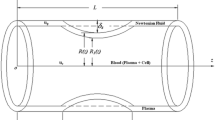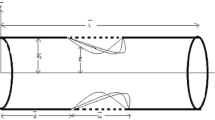Abstract
Heat and fluid flow characteristics of blood flow in multi-stenosis arteries in the presence of magnetic field is considered. A mathematical model of the multi-stenosis inside the arteries is introduced. A finite difference scheme is used to solve the governing equations in terms of vorticity-stream function along with their boundary conditions. The effect of magnetic field and the degree of stenosis on wall shear stress and Nusselt number is investigated. It was found that magnetic field modifies the flow patterns and increases the heat transfer rate. The severity of the stenosis affects the wall shear stress characteristics significantly. The magnetic field torque will increase the thermal boundary layer thickness and the temperature gradient in the streaming blood, and hence increasing the local Nusselt number








Similar content being viewed by others
Abbreviations
- B :
-
magnetic flux intensity, Weber/m2
- C f :
-
friction factor
- C p :
-
specific heat of blood, kJ/kg K
- D o :
-
diameter of the artery, m
- E :
-
electric field intensity, V/m
- Ec :
-
Eckert number
- Ha :
-
Hartmann number
- J :
-
current density, Amp/m2
- L :
-
artery length, m
- k :
-
thermal conductivity of blood, W/m K
- p :
-
pressure, Pa
- Pr :
-
Prandtl number
- R o :
-
dimensional radius of the artery, m
- Re :
-
Reynolds number
- T W :
-
wall temperature, K
- t:
-
time, s
- u :
-
axial velocity, m/s
- U :
-
dimensionless axial velocity
- U 0 :
-
average velocity at inlet, m/s
- v :
-
radial component of velocity, m/s
- V :
-
dimensionless radial velocity
- x :
-
axial coordinate, m
- r :
-
radial coordinate, m
- \({X,\hat{r}}\) :
-
dimensionless coordinates
- η:
-
transverse coordinate in physical domain
- μ:
-
dynamic viscosity of blood, Kg/m s
- θ:
-
non-dimensional temperature
- ρ:
-
density of blood, Kg/m3
- σ:
-
electrical conductivity, \({\frac{1}{{\Omega {\rm m}}}}\)
- τ:
-
shear stress at wall, N/m2
- α:
-
degree of stenosis, %
- ω:
-
vorticity function defined in Eq. 13
- ψ:
-
stream function
References
Andersson HI, Haden R, Glomsaker T (2000) Effect of surface irregularities on flow resistance in differently shaped arterial Stenoses. J Biomech 33:1257–1262
Chakravarty S, Sannigrahi A (1999) A nonlinear mathematical model of blood flow in a constricted artery experiencing body acceleration. Math Comput Model 29:9–25
Cheng CP, Parker D, Taylor CA (2000) Quantification of wall shear stress in large blood vessel using Lagrangian interpolation functions with cine phase-contrast magnetic resonance imaging. Ann Biomed Eng 30:1020–1032
Das B, Batra RL (1995) Non-Newtonian flow of blood in atherosclerotic blood vessel with rigid permeable walls. J Theor Biol 175:1–11
EL-Shehawey EF, Elbarbary E, AFIFI N, Elshahed M (2000) MHD flow of an elastico-viscous fluid under periodic body acceleration. Int J Math Math Sci 23(11):795–799
Lorenzini G (2005) Blood velocity field numerical assessment using a GPL code in case of intravascular Doppler catheter affections: comparative analysis of different rheological models. J Biomech 38(10):2058–2069
Kirkovskaya VV, Mukharskaya YA (2003) Influence of a variable magnetic field on the rheological properties of blood in treatment of rheumatoid arthritis. J Eng Phys Thermophys 76(3):708–714
Moayeri MS, Zendehbudi GR (2003) Effect of elastic property of the wall on flow characteristics through arterial stenosis. J Biomech 36:525–535
Panton R (1984) Incompressible flow. Wiley, New York
Sinha P and Singh C (1984) Effects of couple stress on the blood flow through an artery with mild stenosis. Biorheology 21:303–315
Perktold K and Rappitsch G (1995) Computer simulation of local blood flow and vessel mechanics in a compliant catroid artery bifurcation model. J Biomech 28:845–856
Rai KN, Rai SK (1999) Heat transfer inside the tissues with a supplying Vessel for the case when metabolic heat generation and blood Perfusion are temperature dependent. Heat Mass Transf 35:345–350
Sarkar A and Jayaraman G (1998) Correction to flow rate-pressure drop in coronary angioplasty: steady streaming effect. J Biomech 31(9):781–791
Yao H, Ang KC, Yeo JH, Sim EK (2000) Modelling of blood flow through curved stenosed arteries. J Med Eng Technol 24:163–168
Author information
Authors and Affiliations
Corresponding author
Rights and permissions
About this article
Cite this article
Tashtoush, B., Magableh, A. Magnetic field effect on heat transfer and fluid flow characteristics of blood flow in multi-stenosis arteries. Heat Mass Transfer 44, 297–304 (2008). https://doi.org/10.1007/s00231-007-0251-x
Received:
Accepted:
Published:
Issue Date:
DOI: https://doi.org/10.1007/s00231-007-0251-x




